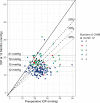Effectiveness and safety of XEN45 implant over 12 months of follow-up: data from the XEN-Glaucoma Treatment Registry
- PMID: 37414935
- PMCID: PMC10764778
- DOI: 10.1038/s41433-023-02642-5
Effectiveness and safety of XEN45 implant over 12 months of follow-up: data from the XEN-Glaucoma Treatment Registry
Abstract
Objectives: To evaluate the 1-year effectiveness and safety of the XEN45, either alone or in combination with phacoemulsification, in glaucoma patients.
Methods: This multicentre, prospective, observational study included consecutive eyes of glaucoma patients from the Italian XEN-Glaucoma Treatment Registry (XEN-GTR) who underwent XEN45 alone or in combination with phacoemulsification, with at least 1 year of follow-up. Surgical success was defined as intraocular pressure (IOP) < 18 mmHg and ≥20% reduction from preoperative IOP, over 1 year of follow-up.
Results: Two hundred thirty-nine eyes (239 patients) were analyzed, 144 (60.2%) eyes in the XEN-solo and 95 (39.8%) eyes in the XEN+Phaco groups. One hundred-sixty-eight (70.3%) eyes achieved overall success, without statistically significant differences between study groups (p = 0.07). Preoperative IOP dropped from a median (IQR) of 23.0 (20.0-26.0) mmHg to 14.0 (12.0-16.0) mmHg at month 12 (p < 0.001), with overall 39.9 ± 18.3% IOP reduction. The mean number of preoperative ocular hypotensive medications (OHM) was significantly reduced from 2.7 ± 0.9 to 0.5 ± 0.9 at month 12 (p < 0.001). Preoperative IOP < 15 mmHg (HR: 6.63; 95%CI: 2.61-16.84, p < 0.001) and temporal position of the surgeon (HR: 4.25; 95%CI: 2.62-6.88, p < 0.001) were significantly associated with surgery failure. One hundred-forty-six (61.1%) eyes had no intraoperative complications, whereas 91 (38.1%) and 56 (23.4%) eyes experienced at least one complication, respectively early (< month 1) and late (≥ month 1), all self-limiting or successfully treated without sequelae. Needling occurred in 55 (23.0%) eyes at least once during follow-up.
Conclusion: Over 1-year follow-up, XEN45 alone or in combination with phacoemulsification, had comparable success rates and effectively and safely lowered IOP and the need for OHM.
© 2023. The Author(s).
Conflict of interest statement
FO: Allergan Abbvie, Santen. PN: Thea, Santen, Hoya. AF: Allergan Abbvie, Glaukos, Ivantis, EyeD. GR; SG; CP; GG; LA; TMF; LM; VP; MS; GM; RA; GS; AP; MU; CC; MM; MF: none.
Figures



References
-
- Lichter PR, Musch DC, Gillespie BW, Guire KE, Janz NK, Wren PA, et al. Interim clinical outcomes in the collaborative initial glaucoma treatment study comparing initial treatment randomized to medications or surgery. Ophthalmology. 2001;108:1943–53. - PubMed
-
- Burr J, Azuara-Blanco A, Avenell A. Medical versus surgical interventions for open angle glaucoma. Cochrane Database of Systematic Reviews. 2004:CD004399. 10.1002/14651858.CD004399.pub2. - PubMed

